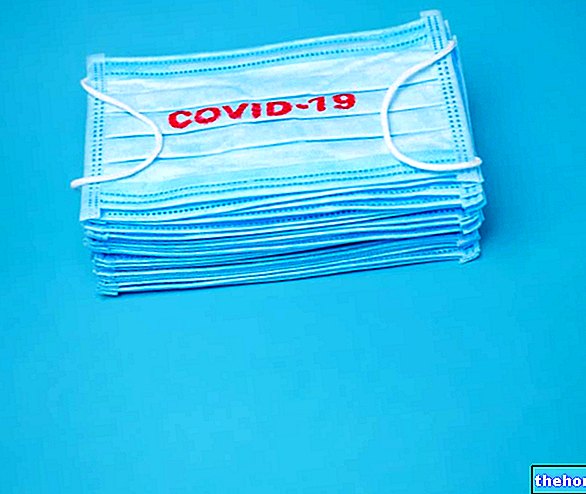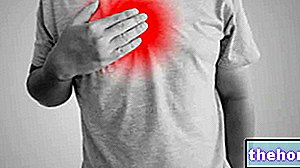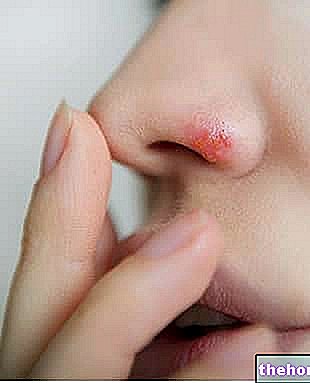Generality
Molds are eukaryotic-type organisms, consisting of more than one cell and belonging to the kingdom of fungi.
Heterotrophic living beings, molds can have toxic, allergic or pathogenic properties towards humans.

The hyphae are the filamentous structures that make up the so-called mycelium (or vegetative body).
Under certain environmental conditions, many molds can become yeasts; this ability takes the name of dimorphism and the fungi that are protagonists take the name of dimorphic fungi.
The main molds with toxic, allergic or pathogenic properties for humans and other animals include: Stachybotrys chartarum, Cladosporium herbarum, Aspergillus fumigatus, some muffedel genus Trichophyton, Penicillium marneffei And Histoplasma capsulatum.
Brief reminder on mushrooms
Fungi constitute a kingdom of living organisms of the eukaryotic type, whose cells have some characteristics of animal cells (mitochondria, heterotrophy, etc.), some characteristics of plant cells (cell wall and vacuole) and some characteristics of bacterial cells (self-synthesis of "amino acid L-lysine).
There are many types of fungi, from unicellular ones - that is composed of only one cell - to multicellular ones - that is, formed by more than one cell; from the saprophytic ones to the parasitic ones, from the edible ones to the pathogenic ones for the human being and not only etc.
Their history is very ancient; according to some studies, in fact, the first fungi would have been present on Earth as early as 3.5 billion years ago.
What are molds?
Molds (in the singular mold) are multicellular organisms, visible even to the naked eye, belonging to the kingdom of fungi.
There are many living molds on Earth: currently, experts say that there are several thousand known mold species.
In this article, the molds that are the subject of the most attention are molds with toxic, allergic or pathogenic properties.
Molds with toxic, allergic or pathogenic properties are a particular category of fungi capable of causing, respectively, toxic reactions, allergic reactions or diseases in humans or other living beings.
Other fungi with pathogenic properties (but not toxic or allergic!) Are yeasts.
Unlike molds, yeasts are unicellular organisms, not visible to the naked eye; in other words, they are microorganisms.
Table showing the scientific classification of molds
Domain:
Eukaryote
Kingdom:
Mushrooms
WHO CARES ABOUT THE STUDY OF TOXIC, ALLERGIC OR PATHOGENIC MOLDS?
Molds with toxic, allergic or pathogenic properties and, in general, all fungi capable of causing disease in humans, are the subject of study by the branch of medicine known as medical mycology.
Mycology is the term that indicates the biomedical discipline that studies fungi in general.
WHAT KIND OF DISEASES CAUSE PATHOGENIC MOLD?
Diseases caused by pathogenic molds (and in general by all fungi with pathogenic properties) are infectious diseases or infections.
In specialist jargon, infections from mold and pathogenic fungi in general are called mycosis.
The mycoses are many; to simplify the study, the doctors decided to classify them according to the site of infection. It resulted that mycoses can be divided into 5 large groups (or types): superficial mycoses, cutaneous mycoses, subcutaneous mycoses (or mycoses subcutaneous), systemic mycoses due to primary pathogens and systemic mycoses due to opportunistic pathogens.
The most famous pathogenic molds are usually responsible for cutaneous mycoses, subcutaneous mycoses or systemic mycoses (N.B: systemic mycoses of both types).
Biology
Being fungi, molds are eukaryotic organisms. A eukaryotic organism is a living being whose cells possess:
- A specialized compartment, which takes the name of nucleus and which is the seat of DNA (or genetic material);
- A DNA organized into chromosomes;
- A series of organelles and
- A complex system of intracellular phospholipid membranes.
Typically, molds have a thick cell wall, made up of 75% chitin and 25% protein / lipids.
THEY ARE HETEROTROPHIC ORGANISMS
Molds and fungi in general are heterotrophic organisms.
A heterotrophic organism is a living being unable to synthesize the organic substances, necessary for life, starting from inorganic substances; in order to survive, heterotrophic organisms must feed on the organic substances produced by other organisms.
Living beings capable of synthesizing organic substances from inorganic substances are called autotrophic organisms. In nature, the autotrophic organisms par excellence are plants, which produce organic substances starting from inorganic substances through the process of photosynthesis.
PLAYBACK
All species of molds, from those with pathogenic properties to those with allergic properties and so on, have the particularity of reproducing by sporogenesis, that is, through the production of spores.
Comparison with yeasts
All yeasts, both pathogenic and non-pathogenic, are characterized by two modes of reproduction: the so-called binary cleavage and the so-called budding.
HABITAT TYPICAL
Most molds like habitat ideal for their own growth and survival, hot and humid environments.
However, it is important to point out that there are molds capable of surviving without problems in environments considered hostile to life. For example, there are:
- Molds that survive without problems in very cold environments. These organisms are the molds that can live inside the refrigerators of the house or in the snowy grounds;
- Molds that survive without problems in dry and drought environments. These organisms are called xerophilous molds;
- Molds that survive in contact with highly acidic solvents, soaps with antibacterial properties and petroleum products.
Where is the human being most likely to come into contact with molds?
Humans are more likely to come into contact with mold by visiting antique shops, saunas, greenhouses, mills, farms, flower shops and summer cottages.
MOLDS HAVE PHAS
Molds possess the ability to produce hyphae (singular hypha).
The hyphae are the filamentous and multicellular structures, which, in all fungi (except yeasts), form the so-called mycelium (or vegetative body) and distinguish the fungal process known as vegetative growth.
Through the hyphae, molds and fungi in general absorb nutrients.

MOLDS CAN ALSO BE YEAST: DIMORPHISM IN MUSHROOMS
In particular environmental conditions or in other circumstances, some species of molds can become yeasts. Molds capable of transforming into yeasts are organisms that from multicellular become unicellular and that lose the ability to produce hyphae, due to the mycelium.
The ability of some fungi to be, on some occasions, molds and, in others, yeasts, is called dimorphism; fungi that can be molds or yeasts, depending on certain environmental conditions (eg: temperature, etc.), are called dimorphic fungi.
Dimorphism is a capacity that affects many fungi with allergic, toxic or pathogenic properties.
In biology, the term dimorphism refers to the phenomenon whereby an individual of the same living species is capable of assuming two different aspects or forms.
A dimorphic individual, therefore, is a subject that can present itself in two different forms.
Clinic
The medical conditions, which some molds can induce in humans, depend on various factors, including:
- The general health of the person who comes into contact with the dangerous mold e
- The state of growth and development of dangerous mold (for example, an environment that favors the growth of a certain mold makes it more prone to cause health problems in a given individual).
MOLD WITH TOXIC PROPERTIES
Molds with toxic properties exert their toxic power through the so-called mycotoxins (N.B: the prefix "mico", before the word "toxins", indicates that they are the "mushroom toxins").
Mycotoxins are secondary metabolites, which molds and all fungi with toxic properties produce under certain environmental conditions. This means that the production (or biosynthesis) of mycotoxins depends on factors such as: the temperature, the presence of water in the surrounding environment, the environmental pH, etc.
Typically, mycotoxins reside in the spores (which are the result of the sporogenesis process) and / or in the environmental substrate that hosted the mold with toxic properties, during the growth phase.
The toxic capacity of mycotoxins depends on the quantity of the latter: high quantities are much more dangerous than modest or negligible quantities; even, the same mycotoxin can be lethal, in large doses, and almost without harmful effects, in small doses.
Mycotoxins deriving from molds with toxic properties can have effects on the liver (hepatotoxins), renal (nephrotoxins), neurological (neurotoxins) and / or immune (immunotoxins) level; moreover, they can alter cellular DNA (mutations) and trigger tumor-like processes (mycotoxins with mutagenic, teratogenic and / or carcinogenic effects).
Mycotoxin poisoning takes the specific name of mycotoxicosis.
Generally, to allow the entry of mycotoxins into the human organism are: ingestion (of the toxic substance), skin exposure (to the toxic substance) and inhalation (of the toxic substance).
Aflatoxin
Citrinine
Alkaloids of ergot
Fumonisin
Ochratoxin
Tricotocene (plural tricotocenes)
Zearalenone
MOLD WITH ALLERGIC PROPERTIES
Molds can have allergic properties in people who have a particular hypersensitivity to spores, hyphae or fragments of hyphae; in case of a hypersensitivity towards them, spores, hyphae and hyphae fragments are to be considered allergens.
The typical effects of molds with allergic properties consist of: eye irritation, nasal congestion, rhinorrhea, allergic rhinitis, allergic asthma, hypersensitivity pneumonitis and / or extrinsic allergic alveolitis.
Generally, exposure to small amounts of molds with allergic properties is ineffective; exposure to large amounts is dangerous.
The way of access to the human organism of molds with allergic properties is the respiratory tract. Hence, it is the inhalation of allergens that causes the aforementioned effects.
MOLD WITH PATHOGENIC-INFECTIOUS PROPERTIES
Generally, molds and all fungi with pathogenic properties are harmless or scarcely infectious for people in good health, while they are very dangerous, so much so as to cause life-threatening infections, for individuals who have an ineffective immune system.
The immune system is the defensive barrier of an organism against threats coming from the external environment, such as viruses, bacteria, fungi, etc., but also from the internal environment, such as cancer cells (the so-called "crazy cells" ) or malfunctioning.
To affect the efficiency of the human immune system can be morbid conditions, such as AIDS (ie HIV infection) or the intake of certain drugs, such as corticosteroids, chemotherapy or immunosuppressants.
Furthermore, it should be remembered that an inefficient immune system is typically present in very young subjects (N.B: it is not yet fully developed) and in very elderly subjects (N.B: it undergoes a physiological decrease in effectiveness).
Other conditions that can favor the development of an infection after contact with a potentially pathogenic mold are diabetes and inadequate or long-term antibiotic intake.
Examples
There are many varieties of molds with toxic, allergic or pathogenic properties. This chapter is dedicated to the best known varieties, such as the "Aspergillus fumigatus, the Penicillium marneffei, the Cladosporium carionii, such molds Trichophyton, lo Stachybotrys chartarum etc.
SOME EXAMPLES OF MOLD WITH TOXIC PROPERTIES
Among the best known examples of molds with toxic properties are:
- Stachybotrys chartarum: it is a black-green mold, which is found very frequently on the surface of plasterboard, cardboard, paper and gauze. With a gelatinous consistency, it prefers very humid and water-rich environments.
A mycotoxicosis from Stachybotrys chartarum it is responsible for a broad symptom picture, which includes: respiratory problems, skin inflammation, bleeding, irritation of the mucous membranes, damage to internal organs, mental confusion, fatigue, nausea and depression of the immune system. - Trichoderma longibrachiatum: it is a mold of the genus Trichoderma, which prefers very humid environments.
On the human being, the toxic power of its mycotoxins depends on a particular amino acid, known as α-aminoisobutyric acid. This particular amino acid, in fact, is able to interfere with the potassium and sodium ion channels of the cell membranes of cardiomyocytes. pneumocytes and neurons.
Trichoderma longibrachiatum mycotoxins are, in fact, neurotoxins. - Memnoniella echinata: is akin to Stachybotrys chartarum.
SOME EXAMPLES OF MOLD WITH ALLERGIC PROPERTIES
Among the best known molds with allergic properties, the following stand out:
- Some molds of the Cladosporium. The most common example is Cladosporium herbarum.
- Some such molds Alternaria. The typical example is Alternaria alternata.
- Some such molds Penicillium. The classic example is Penicillium notatum.
- Some such molds Aspergillus. The classic example is Aspergillus fumigatus.
SOME EXAMPLES OF MOLD WITH PATHOGENIC / INFECTIOUS PROPERTIES
Among the best known molds with pathogenic / infectious properties, they deserve a mention:
- Some such molds Aspergillus, including the aforementioned Aspergillus fumigatus And Aspergillus flavus. The resulting infection is a systemic mycosis of the “systemic mycosis due to opportunistic bacteria”, called Aspergillosis.
Aspergillosis is responsible, above all, for an inflammation of the respiratory tract, the symptoms of which are reminiscent of pneumonia.
For people with underperforming immune systems, it is potentially lethal.
Ways of access to the human body: respiratory tract, digestive system and vascular system. - Penicillium marneffei: it is a dimorphic fungus, which causes a systemic mycosis identified with the name of penicilliosis and falling within the typology of systemic mycoses due to opportunistic pathogens. Very frequent and potentially fatal among AIDS patients, systemic mycoses induced by Penicillium marneffei generally cause: fever, anemia, weight loss, papule-like skin lesions, generalized lymphadenopathy and hepatomegaly.
Ways of access to the human body: respiratory tract, digestive system and vascular system. - Blastomyces dermatitidis. It is a dimorphic fungus (therefore it exists both in the form of yeast and in the form of a fungus), which causes a systemic mycosis identified with the name of blastomycosis and falling within the typology of systemic mycoses due to primary pathogens.
Blastomycosis is characterized by symptoms that resemble that of pneumonia (difficulty breathing, cough, chest pain, etc.), fever, hot flashes, joint pain, myalgia, headache, skin rash, weight loss, etc.
Ways of access to the human body: respiratory tract. - Histoplasma capsulatum: it is a dimorphic fungus that causes a systemic mycosis known as histoplasmosis and belonging to the type of systemic mycoses due to primary pathogens. Potentially lethal for AIDS patients and all people with reduced immune defenses, histoplasmosis is particularly characterized by pulmonary symptoms.
Ways of access to the human body: respiratory tract. - Paracoccidioides brasiliensis: it is a dimorphic fungus responsible for a systemic mycosis, known as paracoccidioidomycosis (or South American blastomycosis) and belonging to the type of systemic mycoses due to primary pathogens.
Paracoccidioidomycosis involves various organs and tissues in the body, including the lungs (most affected organs), arteries, spleen, bones, and meninges.
The most common symptoms consist of fever, cough and weight loss.
Ways of access to the human body: respiratory tract. - Molds like that Trichophyton. Responsible cutaneous mycoses (or tigne), the best known species of the genusTrichophyton I'm: Trichophyton rubrum, Trichophyton mentagrophyes And Trichophyton verrucosum.
Trichophyton rubrum causes cutaneous mycosis (or ringworm), in the feet, hands, groin and / or nails. Readers are reminded that nail fungus is better known as onychomycosis.
Trichophyton mentagrophyes it is the infectious agent responsible for the condition known as athlete's foot. Athlete's foot is a cutaneous mycosis that affects the areas between the toes and causes: red itchy skin, skin thickening, skin peeling, blistering, cracking of the skin, smelly feet and thicker nails.
In the end, Trichophyton verrucosum it is responsible for cutaneous mycosis especially among horses, donkeys, dogs and sheep; only in rare cases it also infects the human being. In the latter, it affects the scalp, causing alopecia or baldness. Typically, humans who contract Trichophyton infections verrucosum they live in close contact with the aforementioned categories of animals.
Further molds with pathogenic properties, of which we will limit ourselves to indicating the genus and type of infection, are: molds Coccidioides immitis And Coccidioides posadasii - which cause coccidioidomycosis (or valley fever) - and molds like that Zigomycota (or Zygomycetes) - which cause the so-called zygomycosis.
















.jpg)











